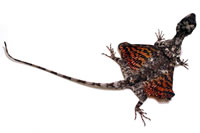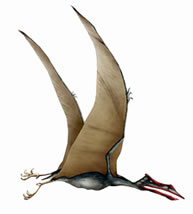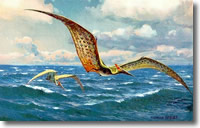Flight in Reptiles: The Pterosaurs
Richard P. Hilton
Dept. of Earth Science, Sierra College

Flight is a complicated function that took life literally billions of years to achieve. Insects were the first masters of the sky, evolving wings nearly 400 million years ago. However, it was not until the Mesozoic (250-65 million years ago) that reptiles achieved flight, and it took until the Cenozoic (65 million years +) before mammals (bats) took to the air. Although today we have flying fish, flying squirrels, and even flying lizards, these are not true flyers but, rather, sophisticated gliders. Very specialized bones, muscles, and respiratory and circulatory sophistication are required for vertebrates to achieve the incredible coordination and stamina necessary for sustained flight.
Pterosaur Fossils Rare
Although birds evolved from dinosaurs during the Mesozoic (250-65 million years ago) another non-dinosaurian reptile also took the air, the pterosaurs. Fossils of pterosaurs are extremely rare. In order to fly, these creatures had to have exquisitely thin and often hollow bones, which are fragile and thus not likely to be preserved as fossils. Those that did become embedded in rock are again easily broken and crushed. Some are simply so small that they are easily overlooked. Unlike birds that use feathers as flight surfaces, pterosaurs solved the problem of flight by having a long extended finger attached to a broad expanse of skin that trailed back along its body in the rear. Their fossils have been found primarily in marine sedimentary rocks, perhaps indicating that many pterosaurs were like pelicans and other ocean birds in lifestyle. But remains have also been found in floodplain deposits and desert dunes, and some of those far from shore. This perhaps shows a diversity of living habits or migrations of some species to inland areas during storms or breeding seasons. A pterosaur nesting site was found in a desert far inland from the South American shore.
California Pterosaurs

The remains of three pterosaurs have been found in California, two from Butte County and one from Shasta County. Also, a wing bone and two vertebrae of a pterosaur were found in marine Late Cretaceous (~70million years ago) rocks of eastern Oregon. These fragments probably represent a species close to a huge pterosaur called Quetzalcoatlus. The presence of Late Cretaceous pterosaur remains in Oregon and northern California suggests these creatures may have been widespread in the Mesozoic west coast.

The two Butte County pterosaur bones, a fourth metacarpal and an ulna are from the wings of two large pterosaurs. The largest bone is the seventeen-inch finger bone. It would scale out to an animal with an approximate wingspan of at least fifteen to eighteen feet. The best candidate is Pteranodon, a toothless, crested pterosaur, the largest of which had a wingspan exceeding thirty feet. The skull alone of was nearly six feet long; it had relatively small eye sockets and a short neck, but its long wings enabled it to glide great distances. Imagine a pterosaur the size of a modern jet fighter swooping down as you walked along a lonely beach.
